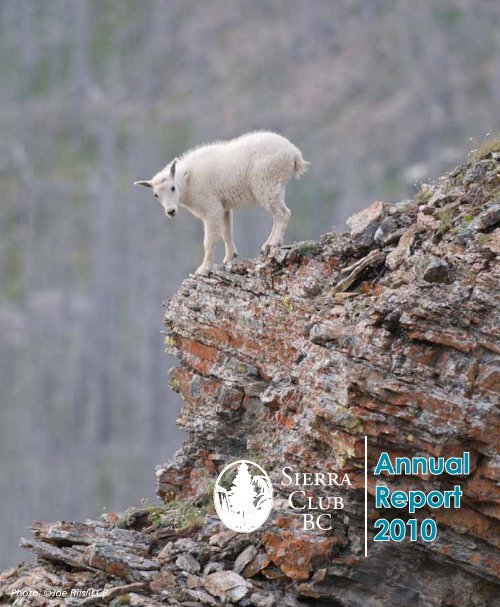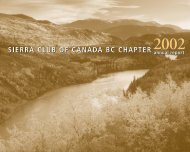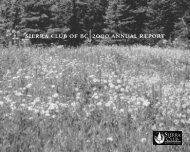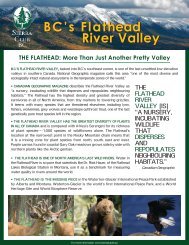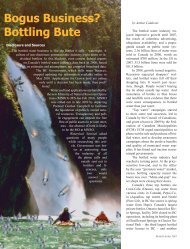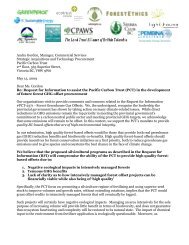Annual Report 2010 - Sierra Club BC
Annual Report 2010 - Sierra Club BC
Annual Report 2010 - Sierra Club BC
You also want an ePaper? Increase the reach of your titles
YUMPU automatically turns print PDFs into web optimized ePapers that Google loves.
<strong>Annual</strong><br />
<strong>Report</strong><br />
<strong>2010</strong><br />
Photo: ©Joe Riis/iLCP<br />
1
2<br />
Great Bear Rainforest<br />
Photo: Daryl Spencer<br />
<strong>Sierra</strong> <strong>Club</strong> <strong>BC</strong> is a non-profit<br />
environmental organization whose mission<br />
is to protect and conserve British Columbia’s<br />
wilderness, species and ecosystems, within<br />
the urgent context of global warming.<br />
We advocate the responsible use of B.C.’s<br />
natural resources while promoting a modern,<br />
equitable economy that sustains our planet in<br />
every way.
Celebrating a Year of <strong>Sierra</strong> <strong>Club</strong> <strong>BC</strong>’s<br />
Environmental Accomplishments<br />
Dear Friends,<br />
At <strong>Sierra</strong> <strong>Club</strong> <strong>BC</strong> we have a tradition of celebrating successes and birthdays at our<br />
Tuesday afternoon staff meetings. For a brief time, we leave behind our computers<br />
and telephones to share baked goodies and make a lively toast. This past year--<br />
brimming with major accomplishments, hard-fought battles and amazing partnerships--<br />
offered memorable occasions to make merry.<br />
In February, our Flathead River Valley campaign achieved a landmark success when the<br />
provincial government banned mining and oil and gas development in this wildlife nursery<br />
in southeastern B.C., putting an end to plans for mountain top removal coal mining. In<br />
March, a report we co-published drew attention to Great Bear Rainforest species, including<br />
the rare white “Spirit” bear, which remain at great risk as the B.C. government lags on<br />
commitments to map critical habitat. In December, our partner Ecojustice won an important<br />
court decision on our behalf, aimed at protecting endangered orca whales.<br />
Behind every great environmental organization stands a posse of supporters. The successes<br />
of <strong>2010</strong> were only made possible with your steadfast help and generosity.<br />
With your assistance, in <strong>2010</strong> our award-winning education program reached more than<br />
8,000 school children around the province, helping to cultivate the next generation of<br />
environmental stewards. Our six <strong>Sierra</strong> <strong>Club</strong> local groups continued to take action on urgent<br />
environmental issues in their communities, with the Victoria group launching a fabulously<br />
interactive outings program. As <strong>Sierra</strong> <strong>Club</strong> founder John Muir famously wrote: “Everybody<br />
needs beauty as well as bread, places to play in and pray in, where nature may heal and give<br />
strength to body and soul alike.”<br />
Please join us in 2011 as we tackle environmental issues from one corner of our province<br />
to another. B.C.’s environment needs our help more than ever before. You can watch our<br />
website for daily updates on our efforts to protect B.C.’s wilderness and wildlife, a mission<br />
ever more pressing given the latest information about the alarming impacts of global<br />
warming. Feel free to share this report with others whom you think may be interested in<br />
our work. And do stay in touch with us – through our website, Facebook, Twitter, You Tube,<br />
our online blog Wild, or by attending <strong>Sierra</strong> <strong>Club</strong> <strong>BC</strong> events in your community.<br />
With thanks,<br />
George Heyman<br />
Executive Director<br />
3
4<br />
Flathead River Valley<br />
Photo: © Garth Lenz/iLCP
FLATHEAD RIVER VALLEY<br />
Working to Permanently Protect<br />
B.C.’s Lush Southeastern Corner<br />
Management Area in the rest of the valley<br />
and adjoining habitat.<br />
Flathead Valley - Cougar<br />
Photo: © Matthias Breiter/iLCP<br />
<strong>Sierra</strong> <strong>Club</strong> <strong>BC</strong> played a major role in<br />
stopping a coal strip mine slated for<br />
the Flathead River Valley, successfully<br />
pressuring the B.C. government to announce<br />
a ban on mining and energy development in<br />
the Flathead.<br />
World Heritage Committee petition<br />
The February <strong>2010</strong> ban came after <strong>Sierra</strong><br />
<strong>Club</strong> <strong>BC</strong> and other groups petitioned the<br />
World Heritage Committee asking that<br />
Waterton-Glacier International Peace Park,<br />
adjacent to the Flathead, be declared<br />
a World Heritage Site in Danger due to<br />
mining and other threats. In July <strong>2010</strong>, the<br />
World Heritage Committee issued a report<br />
calling for increased protection for the<br />
Flathead, including a transboundary wildlife<br />
conservation area.<br />
Flathead still under threat<br />
In the absence of permanent protection,<br />
the Flathead remains under threat from<br />
industrial logging, quarrying, trophy<br />
hunting of grizzlies and other animals, and<br />
new road access. <strong>Sierra</strong> <strong>Club</strong> <strong>BC</strong> continues to<br />
press for a national park in the southeastern<br />
one-third of the Flathead, as an expansion<br />
of Waterton-Glacier, and a Wildlife<br />
Friends of the Flathead milestone<br />
In October <strong>2010</strong>, our group Friends of<br />
the Flathead reached a milestone of 10,000<br />
members. We also partnered with Denman<br />
Island Chocolate to produce two specialedition<br />
Flathead Wild chocolate bars, with<br />
one wrapper featuring a Flathead grizzly<br />
and the other a Flathead mountain goat.<br />
Photo: Caitlyn Vernon<br />
We hiked up to the continental<br />
divide and looked down at the<br />
Flathead River Valley, a green nursery<br />
for wildlife. Behind us stretched<br />
Waterton-Glacier International Peace<br />
Park, a World Heritage Site and<br />
UNESCO Biosphere Reserve. B.C.’s<br />
Flathead is part of the same ecosystem<br />
as Waterton-Glacier, and <strong>Sierra</strong> <strong>Club</strong><br />
<strong>BC</strong> is working hard to make sure it has<br />
the same level of protection.<br />
— Sarah Cox,<br />
Communications Director<br />
and Flathead Campaign Manager<br />
5
6<br />
Great Bear Rainforest - Wolf pup<br />
Photo: © Marven Robinson/iLCP
Great bear rainforest<br />
Ensuring Protection for the Largest<br />
Intact Rainforest in B.C.<br />
Sunset in the Great Bear<br />
Photo: © Jack Dykinga/iLCP<br />
<strong>Report</strong> highlights anniversary<br />
<strong>Sierra</strong> <strong>Club</strong> <strong>BC</strong> co-authored the report,<br />
Slipping Through the Cracks The<br />
Fate of Focal Species in the Great Bear<br />
Rainforest, to mark the one-year anniversary<br />
of the 2009 Great Bear Agreements<br />
endorsed by environmental organizations,<br />
First Nations, the B.C. government and<br />
industry. The report pointed out that grizzly<br />
bears, mountain goats, northern goshawks<br />
and other key species remain at risk in the<br />
Great Bear Rainforest.<br />
It called on the B.C. government to<br />
implement new species conservation<br />
measures identified as a priority by all<br />
parties in 2009, and to put on hold on new<br />
logging approvals and road permits until<br />
crucial habitat is set aside for focal species.<br />
<strong>Sierra</strong> <strong>BC</strong> continued to work with our<br />
partners in the Rainforest Solutions Project<br />
to fully implement the Great Bear Rainforest<br />
conservation model and promote similar<br />
solutions, protecting species and carbon<br />
storage in other parts of the province.<br />
Photographing the rainforest<br />
In September, <strong>Sierra</strong> <strong>Club</strong> <strong>BC</strong> was a<br />
partner in the Great Bear RAVE (Rapid<br />
Assessment Visual Expedition), a project of<br />
the International League of Conservation<br />
Photographers. World-renowned<br />
photographers fanned out in the Great<br />
Bear, on land and sea, to capture images of<br />
the stunning beauty of the world’s largest<br />
intact coastal temperate rainforest. The<br />
images will be used by conservation groups<br />
to draw international attention to proposed<br />
oil tanker traffic through Great Bear, which<br />
would put the region at risk of an oil spill<br />
like the Exxon Valdez disaster.<br />
Photo: Kirsten Zickfeld<br />
Working on the implementation<br />
of the Great Bear Rainforest<br />
Agreements with government and<br />
industry is a lot of hard work! But<br />
looking through the RAVE photos<br />
really brings home how much is<br />
at stake here if oil tanker traffic<br />
is allowed to criss-cross the Great<br />
Bear. B.C. is lucky enough to house<br />
the world’s largest intact coastal<br />
temperate rainforest, and we need to<br />
protect it.<br />
— Jens Wieting,<br />
Coastal Forests Campaigner<br />
7
8<br />
Fishing for halibut during the Great Bear RAVE<br />
Photo: Todd McGowan
Keeping watch on the coast<br />
In March, <strong>Sierra</strong> <strong>Club</strong> <strong>BC</strong> co-organized an<br />
“Ecosystem-Based Management Learning<br />
Forum” in Wuikinuxv Village (Rivers<br />
Inlet), on B.C.’s central coast. First Nations<br />
participants from the central coast, north<br />
coast and Haida Gwaii shared stories and<br />
experiences about their work to ensure the<br />
2009 Great Bear Rainforest Agreements<br />
are implemented — from monitoring new<br />
forestry regulations aimed at conserving<br />
ancient cedar trees to tracking grizzly bear<br />
populations.<br />
<strong>Sierra</strong> <strong>Club</strong> <strong>BC</strong> also played a key role in<br />
developing a regional monitoring strategy<br />
for Coastal First Nations that will enhance<br />
and standardize monitoring efforts up and<br />
down the coast. In May we co-hosted the<br />
annual gathering of the Coastal Guardian<br />
Watchmen Network, bringing together First<br />
Nation practitioners who monitor the health<br />
of ecosystems, watch over important cultural<br />
sites and keep an eye on resource use in<br />
their territories.<br />
FIRST NATIONS<br />
Supporting the Traditional<br />
Guardians of B.C. Lands and Water<br />
Photo: Doug Neasloss<br />
The next generation of stewards<br />
In the summer of <strong>2010</strong>, we provided<br />
support to the Koeye Science and Culture<br />
Camp for Heiltsuk youth, in the heart of the<br />
Great Bear.<br />
Throughout <strong>2010</strong>, we worked with<br />
coastal First Nations to draw attention to<br />
the catastrophic loss of livelihoods and<br />
traditional ways of life that could result<br />
from an oil spill should tankers, carrying<br />
crude piped from the Alberta tar sands, be<br />
allowed to traverse the Great Bear’s perilous<br />
coastal waters.<br />
Photo: Frances Litman<br />
First Nations have always been the<br />
eyes and ears of their territories.<br />
We believe it is important to support<br />
First Nation Guardian Watchmen so<br />
they can be out on the land and water<br />
keeping track of grizzly populations<br />
and doing other important monitoring<br />
work, especially during this era of<br />
severe government cutbacks.<br />
— Caitlyn Vernon,<br />
Coastal Programs Campaigner<br />
9
10<br />
Photo: Norman De Leenheer
endangered species<br />
Standing Up for Strong Species<br />
Protection – in Court and in Law<br />
Orca court decision<br />
In December, <strong>Sierra</strong> <strong>Club</strong> <strong>BC</strong> and other<br />
conservation groups won a landmark<br />
federal court decision aimed at protecting<br />
endangered orca whales.<br />
Represented by Ecojustice, we successfully<br />
argued that the federal government must<br />
legally protect important aspects of critical<br />
habitat for southern and northern resident<br />
orcas, including their food supply.<br />
As we went to press with our annual<br />
report, the federal government was seeking<br />
to overturn the court decision. With the<br />
support of Ecojustice, <strong>Sierra</strong> <strong>Club</strong> <strong>BC</strong> will<br />
continue to press for adequate legal<br />
protection for endangered orcas and their<br />
habitat.<br />
Northern Goshawk<br />
Photo: Steve Garvie<br />
Endangered species law<br />
B.C. is home to more at-risk species than<br />
anywhere else in Canada, yet we are one of<br />
only two provinces without a stand-alone<br />
endangered species law.<br />
In <strong>2010</strong>, <strong>Sierra</strong> <strong>Club</strong> <strong>BC</strong> worked with<br />
mayors and councillors around the province<br />
to gain municipal support for a strong law<br />
to protect species and ecosystems.<br />
We continue to urge the B.C. government<br />
to pass a science-based species and<br />
ecosystem protection law that will protect<br />
habitat needed for the survival and recovery<br />
of more than 2,000 at-risk species in our<br />
province, from the grizzly bear and badger<br />
to mountain caribou and marbled murrelets.<br />
Photo: Dave Duprey<br />
We know that British Columbians<br />
treasure the outdoors and the<br />
range of wildlife in this province. B.C.<br />
needs to follow the lead of other<br />
provinces and pass a strong law to<br />
protect our endangered species and<br />
their habitats.<br />
— Susan Howatt,<br />
Campaigns Director<br />
11
10-10-10 work party in eelgrass habitat<br />
Photo: <strong>Sierra</strong> <strong>Club</strong> <strong>BC</strong><br />
12<br />
Eelgrass<br />
Photo: James Mack
seafood and oceans<br />
Exploring Blue Carbon Sinks and<br />
Promoting Healthy Oceans<br />
great coastal sea, the submarine assesses the<br />
ocean’s health amidst the changing climate.<br />
Oystercatcher<br />
Photo: Jens Wieting<br />
Blue carbon<br />
How surprising would it be if you<br />
suddenly discovered there were<br />
gardens so fertile they could fix<br />
carbon from the atmosphere 50 times<br />
more efficiently than the lushest tropical<br />
rainforest Would it seem like good news It<br />
does to us.<br />
New research in <strong>2010</strong> by <strong>Sierra</strong> <strong>Club</strong><br />
<strong>BC</strong> revealed the tremendous potential of<br />
marine vegetation — like eelgrass meadows<br />
and salt marshes — to moderate global<br />
warming. Our report, Blue Carbon, by <strong>Sierra</strong><br />
<strong>Club</strong> <strong>BC</strong>’s science advisor Colin Campbell, laid<br />
out the case for urgent protection of these<br />
valuable habitats.<br />
<strong>Sierra</strong> Submarine takes the ocean’s<br />
pulse<br />
In February, <strong>Sierra</strong> <strong>Club</strong> proudly presented<br />
our first animation, Code Blue. Designed in<br />
the popular manga style, a <strong>Sierra</strong> submarine<br />
is dispatched on a medical mission — to take<br />
the ocean’s pulse. Voyaging from windswept<br />
Triangle Island to the depth of B.C.’s<br />
Ocean-friendly seafood<br />
In April, as we made the final preparations<br />
for the Get Out Migration with wild salmon<br />
champion Alexandra Morton, there was<br />
welcome news from the retail sector. The<br />
Overwaitea Food Group announced it will<br />
feature farmed salmon raised in closed<br />
containment, away from the ocean —<br />
showcasing a solution called for by salmon<br />
activists across the province.<br />
As part of the Seachoice coalition, <strong>Sierra</strong><br />
<strong>Club</strong> <strong>BC</strong> worked with large retailers such as<br />
Overwaitea, as well as consumers, to offer a<br />
variety of ocean-friendly seafood choices.<br />
Photo: <strong>Sierra</strong> <strong>Club</strong> <strong>BC</strong><br />
Eelgrass beds and salt marshes<br />
effectively bury carbon for<br />
thousands of years. This is probably<br />
the most efficient carbon removal<br />
mechanism on Earth.<br />
— Colin Campbell,<br />
Science Advisor and<br />
Marine Campaign<br />
13
14<br />
<strong>Sierra</strong> <strong>Club</strong> <strong>BC</strong>’s Education Team<br />
Photo: Karin Able
environmental education<br />
Learning From Our Students<br />
Through Hands-On Programs<br />
Meeting B.C.’s educational needs<br />
Each school year, our educators get to see<br />
first-hand the seeds of environmental<br />
stewardship planted in B.C.’s classrooms.<br />
In the <strong>2010</strong>-2011 school year, <strong>Sierra</strong> <strong>Club</strong><br />
<strong>BC</strong> worked with more than 4,500 students<br />
across British Columbia through in-class<br />
presentations and action projects. Our<br />
delivery capacity is never able to meet our<br />
registration demand, making it clear that<br />
schools want more environmental education<br />
in the curriculum. Because demand is<br />
so high, we have continued to provide<br />
environmental education resources for the<br />
classrooms we are unable to visit in person.<br />
Translation in progress<br />
Educators Aude Ray Houle and Meg<br />
Banavage translated our Elementary/Middle<br />
School programs into French, completing<br />
the entire Temperate Rainforest Ecosystem<br />
Education (TREE) Program, called “Pluviale<br />
et l’intendance environnementale” (PLUIE).<br />
They delivered TREE, PLUIE and Climate<br />
Change programs in Victoria and Vancouver,<br />
reaching more than 1,000 students.<br />
For the first time, we hired an educator<br />
to deliver our Going Wild! program to<br />
classes outside of the Great Bear Rainforest.<br />
Educator Julia Morlacci prepared the Non-<br />
Timber Forest Products program for 2011<br />
delivery in the Capital Regional District.<br />
Educator Erich Nahser-Ringer translated<br />
our Sustainable High Schools classroom<br />
presentations, and made them available<br />
to both French and English classrooms<br />
in Victoria and Vancouver, reaching 475<br />
students.<br />
Our Youth Steering Committee, made up<br />
of students from across the Capital Regional<br />
District, worked on various projects,<br />
including a garden at Vic High which will<br />
be used by the school’s cafeteria and foodpreparation<br />
course.<br />
Teaching the teachers<br />
<strong>Sierra</strong> <strong>Club</strong> <strong>BC</strong> facilitated Professional<br />
Development workshops for teachers and<br />
school administrators on such topics as<br />
Non-Timber Forest Products, Sustainable<br />
Happiness, and “How to Green Your<br />
School.”<br />
Photo: Nadine Lefort<br />
Watching kids make connections<br />
between the world around them<br />
and the decisions they make in their<br />
everyday lives is the best part of our<br />
programs. I love hearing their stories<br />
and seeing the enthusiasm they bring<br />
to learning about B.C.’s ecosystems.<br />
— Nadine Lefort,<br />
Education Program Manager<br />
15
16<br />
Fish Lake<br />
Photo: Lee-Anne Stack
mining and power projects<br />
Strengthening the Environmental<br />
Assessment Process in B.C.<br />
Antiquated Mineral Tenure Act<br />
In June, we learned that a Vancouver<br />
mineral exploration company planned<br />
to drill for zinc in endangered mountain<br />
caribou habitat in the Caribou region,<br />
turning a popular hiking trail into a road for<br />
heavy equipment.<br />
<strong>Sierra</strong> <strong>Club</strong> <strong>BC</strong> continued to urge the B.C.<br />
government to follow the example of other<br />
provinces and modernize our antiquated<br />
Mineral Tenure Act so that environmental<br />
and First Nations concerns are taken into<br />
account before mining claims can be made.<br />
Right now, mining claims – made on-line<br />
with the click of a mouse and a Mastercard<br />
– create legal entitlement that supersedes<br />
other potential land uses.<br />
continued working to close the loophole in<br />
federal law that allows Canadian lakes to<br />
be “reclassified” as toxic tailings ponds for<br />
mines, and to improve B.C.’s environmental<br />
assessment standards.<br />
Fish Lake saved by public outcry<br />
Our supporters sprang into action to help<br />
save Fish Lake from being destroyed by the<br />
proposed “Prosperity” gold and copper<br />
mine. Almost 2,000 <strong>Sierra</strong> <strong>BC</strong> followers<br />
wrote letters to the federal government,<br />
urging Ottawa to heed the findings of its<br />
own environmental assessment panel and<br />
prevent Fish Lake, upper Fish Creek and<br />
Little Fish Lake from being converted into a<br />
waste rock dump and tailings ponds.<br />
The campaign, led by the Xeni Gwet’in<br />
First Nation, a member of the Tsilhqot’in<br />
National Government, met with success in<br />
early November when Ottawa overrode a<br />
decision by the B.C. government to approve<br />
destruction of Fish Lake, 125 kilometers<br />
southwest of Williams Lake. <strong>Sierra</strong> <strong>Club</strong> <strong>BC</strong><br />
Peace River Valley<br />
Photo: Larry Petersen<br />
In April, <strong>Sierra</strong> <strong>Club</strong> <strong>BC</strong> Executive<br />
Director George Heyman spoke out<br />
against the massive Site C dam that<br />
the B.C. government plans to build on<br />
the traditional territories of the Treaty<br />
8 First Nations, flooding more than<br />
5,000 kilometers of land in the Peace<br />
Valley region. Heyman called Site C an<br />
“ill-advised” mega-project that fails to<br />
meet minimum international standards<br />
for large dam construction and could<br />
substantially increase B.C.’s carbon<br />
emissions.<br />
17
18<br />
Great Horned Owl babies, Victoria<br />
Photo: Caspar Davis
local groups<br />
Hard at Work Across the Province<br />
Herons save the day<br />
In June, <strong>Sierra</strong> <strong>Club</strong> members in Powell<br />
River halted logging in a beautiful city<br />
park that was slated to become a running<br />
track. Local group members spotted<br />
two herons’ nests and raised the alarm,<br />
preventing the logging. Letters to the editor<br />
and city council poured in. As a result, the<br />
Powell River City Council decided to change<br />
the running track location. They also agreed<br />
to consider a by-law prohibiting tree-cutting<br />
within city limits during nesting season. Two<br />
of the four fledglings survived to leave the<br />
nest!<br />
All hands on deck on Quadra Island<br />
In April, Quadra Islanders turned out en<br />
masse for the beach cleanup organised<br />
by <strong>Sierra</strong> Quadra. Families, businesses and<br />
individuals collected garbage from beaches<br />
throughout April, and the whole community<br />
gathered for a clean-up finale to fill the<br />
trucks and celebrate.<br />
Hometown Heroes<br />
<strong>Sierra</strong> Comox Valley continued its<br />
important work to protect the Courtenay<br />
River estuary. “We are working to make<br />
the Courtenay River Estuary a true econeighbourhood<br />
where humans, and other<br />
species and life-forms, all sharing a common<br />
sense of place, live together in harmony,”<br />
said co-chair Mike Bell.<br />
In recognition of his work to protect<br />
the estuary, Mike Bell was named one of<br />
Canada’s top ten Hometown Heroes — the<br />
only one from B.C. — by the national<br />
charitable group Earth Day Canada.<br />
Proposed Raven coal mine<br />
<strong>Sierra</strong> local groups are working with Coal<br />
Watch Comox Valley to stop the proposed<br />
Raven coal mine near Fanny Bay. The<br />
underground mine would remove 44 million<br />
tonnes of coal over 20 years, which would<br />
be trucked to Port Alberni and shipped to<br />
Asia. <strong>Sierra</strong> <strong>Club</strong> <strong>BC</strong> is concerned about the<br />
impacts of harmful coal dust, noise from<br />
the 24-hour a day operation, loss of salmon<br />
habitat, the threat to the shellfish industry<br />
in nearby Baynes Sound, and potential<br />
contamination of aquifers that supply<br />
drinking water. We continue to keep tabs<br />
on Raven’s progression through the B.C.<br />
environmental assessment process.<br />
Courtesy: Jacques Morin<br />
It has been heartening to see<br />
community after community join<br />
together in solidarity to protect our<br />
coast and livelihoods.<br />
— Jacques Morin,<br />
<strong>Sierra</strong> Haida Gwaii<br />
<strong>Sierra</strong> Haida Gwaii, along with other<br />
island groups, was instrumental in<br />
persuading Haida Gwaii local councils<br />
to join their First Nations neighbours<br />
in a “No Tankers” declaration.<br />
19
OUR SUPPORTERS<br />
Thank You to Our <strong>2010</strong> Funders!<br />
Photo: Nori Sinclair<br />
Foundations<br />
Barthel Foundation<br />
<strong>BC</strong> Government and Service Employees’<br />
Union<br />
<strong>BC</strong> Hydro<br />
<strong>BC</strong> Social Venture Partners Foundation<br />
BMO - GGOF<br />
Board of Education of School District No. 61<br />
(Greater Victoria)<br />
Brainerd Foundation<br />
Canadian Boreal Initiative<br />
Capital Regional District<br />
Chris Spencer Foundation<br />
City of Victoria Special Projects Grants Fund<br />
Columbia Institute<br />
Conservation Alliance<br />
Considine & Company<br />
CUPE B.C.<br />
DBA CNC Repair & Sales<br />
EcoAction Community Funding Program<br />
Employment and Labour Market Services<br />
Division<br />
Federation of Post-Secondary Educators of<br />
<strong>BC</strong><br />
Hamber Foundation<br />
Health Sciences Association of British<br />
Columbia<br />
Laura L. Tiberti Charitable Foundation<br />
Ministry of Advanced Education and Labour<br />
20<br />
Natural Sciences and Engineering Research<br />
Council of Canada<br />
North Growth Foundation<br />
Ontario Ministry of Environment<br />
Provincial Employees Community Services<br />
Fund<br />
S. and A. Inspiration Foundation<br />
Science World Society<br />
Somerset Foundation<br />
SpencerCreo Foundation<br />
Telus Community Engagement (Victoria)<br />
The Nature Conservancy (TNC)<br />
Tides Canada Foundation<br />
Vancity<br />
Vancouver Foundation<br />
Wilburforce Foundation<br />
Willow Grove Foundation<br />
WorkSource Targeted Wage Subsidy<br />
Yellowstone to Yukon Conservation Initiative<br />
YMCA Vancouver<br />
Corporate Supporters<br />
Accent Inns<br />
Artisan Wine Co.<br />
Backstage Technologies Inc<br />
Bluewater Adventures<br />
Carmanah Technologies<br />
Concert Properties<br />
CRMfusion Inc.<br />
Denman Island Chocolate Ltd.<br />
Electronic Arts<br />
Fidelity Investments Canada ULC<br />
Mackenzie Investments<br />
Maple Leaf Adventures<br />
SPUD<br />
Vertical Response<br />
And a special thank you to all of our<br />
individual and monthly donors!
OUR TEAM<br />
<strong>Sierra</strong> <strong>Club</strong> of British Columbia<br />
Foundation Board of Directors <strong>2010</strong><br />
Executive<br />
Jamie Biggar, Chair<br />
Doug McArthur, Vice-Chair<br />
Shirley Franklin, Treasurer<br />
Rahman Saleem, Secretary<br />
Brian Pinch, Past Chair<br />
George Heyman, Executive Director, Staff<br />
Patricia Lane, Member at Large<br />
Tria Donaldson, Member at Large<br />
Stan Tomandl, Member at Large<br />
Martin Golder, Member at Large<br />
Karen Palmer, Member at Large<br />
Local Group Representatives<br />
Victoria Group<br />
Patricia Molchan<br />
Quadra Island Group<br />
Judy Leicester, Conservation Chair<br />
Haida Gwaii Group<br />
Jacques Morin, Chair<br />
Lower Mainland Group<br />
Paul Richard, Interim Chair<br />
Malaspina Group<br />
Betty Zaikow<br />
Comox Valley Group<br />
Mike Bell, Chair<br />
<strong>Sierra</strong> <strong>Club</strong> <strong>BC</strong> Staff <strong>2010</strong><br />
George Heyman, Executive Director<br />
Meg Banavage, Elementary and Middle<br />
School Educator<br />
Rebecca Blumenshine, Manager of Individual<br />
Giving<br />
Colin Campbell, Science Advisor and Marine<br />
Campaign<br />
Moira Chaudhry, Major and Corporate<br />
Giving Steward<br />
Sarah Cox, Communications Director and<br />
Flathead Campaign<br />
Sheila Giesbrecht, Office Manager<br />
Luna Hallam, Youth Engagement<br />
Coordinator<br />
Jennifer Hoffman, Development Director<br />
Aude Ray Houle, Elementary and Middle<br />
School Educator<br />
Susan Howatt, Campaigns Director<br />
Kim Kotanko, Finance Director<br />
Nadine Lefort, Education Program Manager<br />
Dave Leversee, Contractor - GIS Mapper<br />
Helena Mahoney, Sustainable High Schools<br />
Coordinator<br />
Julia Morlacci, First Nations Outreach<br />
Educator<br />
Erich Nahser-Ringer, Sustainable High<br />
Schools Coordinator<br />
Ana Simeon, Communications Coordinator<br />
Nori Sinclair, Communications Assistant<br />
Caitlyn Vernon, Coastal Programs<br />
Campaigner<br />
Jens Wieting, Coastal Forest Campaigner<br />
Maureen Yao, Bookkeeper<br />
Photo: Jens Wieting<br />
21
FINANCIALS<br />
Statement of Operations<br />
For the 12-month period ending December <strong>2010</strong><br />
Revenue:<br />
Grants $541,078<br />
Donations 294,277<br />
Government Funding 47,154<br />
Bequests 27,482<br />
Other Revenue 105,151<br />
Activities carried out under Agency Agreements 54,141<br />
Total Revenue 1,069,283<br />
Expenditures:<br />
Operations 126,766<br />
Development, Supporter Outreach & Engagement* 361,620<br />
Conservation Programs* 336,718<br />
Education* 152,921<br />
Local Groups* 16,731<br />
Activities carried out under Agency Agreements 54,141<br />
Total Expenses 1,048,897<br />
Excess (deficiency) of revenue over expenses $20,387<br />
*includes Communications<br />
Note: In 2009, <strong>Sierra</strong> <strong>Club</strong> <strong>BC</strong> Foundation operated its programs through the <strong>Sierra</strong> <strong>Club</strong><br />
<strong>BC</strong> Chapter under Agency Agreements. Starting in <strong>2010</strong>, administrative changes were<br />
made. Since that time most of the work formerly done by the Chapter (on behalf of the<br />
Foundation) is now done directly by the Foundation. The purpose of the change was to<br />
more effectively manage administration costs and to ensure continued transparency of<br />
operations with respect to Canada Revenue Agency policy respecting registered charitable<br />
organizations. Due to this significant change in operations we have not shown 2009<br />
comparative figures. Please contact us to request this information or our complete audited<br />
financial statements.<br />
22
Program Expenditures<br />
Agency<br />
Agreements<br />
10%<br />
Local Groups<br />
3%<br />
Education<br />
27%<br />
Development,<br />
Supporter Outreach<br />
& Engagement<br />
34%<br />
Organizational Expenditures<br />
Sources of Support<br />
Donations<br />
27%<br />
Operations<br />
12%<br />
Conservation<br />
Programs<br />
60%<br />
Programs<br />
54%<br />
Government<br />
Funding<br />
4%<br />
Bequests<br />
3%<br />
Support Our Work<br />
FINANCIALS<br />
The support of generous individuals<br />
like you has enabled <strong>Sierra</strong> <strong>Club</strong> <strong>BC</strong> to<br />
protect B.C.’s wilderness and wildlife for<br />
more than 40 years. Your donation will<br />
help us continue to be a strong advocate<br />
for B.C.’s environment.<br />
We invite you to join the <strong>Club</strong> by:<br />
• Making a gift to support <strong>Sierra</strong><br />
<strong>Club</strong> <strong>BC</strong>’s overall work<br />
• Directing a gift to a special <strong>Sierra</strong><br />
<strong>Club</strong> <strong>BC</strong> project<br />
• Joining our <strong>Sierra</strong> Sustainers<br />
Monthly Giving Program<br />
• Making a donation of publiclylisted<br />
securities<br />
• Leaving a legacy by<br />
remembering us in your will<br />
Please contact us at 250-386-5255<br />
(Option 1) for more information.<br />
Your gift can also be made online at<br />
www.sierraclub.bc.ca or by mail by<br />
sending a cheque to: <strong>Sierra</strong> <strong>Club</strong> of<br />
<strong>BC</strong> Foundation, 304-733 Johnson St,<br />
Victoria, <strong>BC</strong>, V8W 3C7.<br />
Gifts made to the <strong>Sierra</strong> <strong>Club</strong> of<br />
<strong>BC</strong> Foundation will be used for our<br />
charitable work, such as research and<br />
environmental education, and are<br />
eligible for a tax receipt (Registered<br />
Charity: 11914 9797 RR0001).<br />
Grants<br />
51%<br />
Other<br />
Revenue<br />
15%<br />
23
24<br />
Photo: Nadine Lefort<br />
304-733 Johnson St.<br />
Victoria, <strong>BC</strong> V8W 3C7<br />
250-386-5255 | www.sierraclub.bc.ca | info@sierraclub.bc.ca


